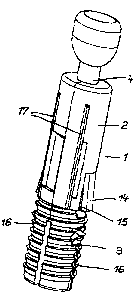Une partie des informations de ce site Web a été fournie par des sources externes. Le gouvernement du Canada n'assume aucune responsabilité concernant la précision, l'actualité ou la fiabilité des informations fournies par les sources externes. Les utilisateurs qui désirent employer cette information devraient consulter directement la source des informations. Le contenu fourni par les sources externes n'est pas assujetti aux exigences sur les langues officielles, la protection des renseignements personnels et l'accessibilité.
L'apparition de différences dans le texte et l'image des Revendications et de l'Abrégé dépend du moment auquel le document est publié. Les textes des Revendications et de l'Abrégé sont affichés :
| (12) Demande de brevet: | (11) CA 2411511 |
|---|---|
| (54) Titre français: | CONNECTEUR DE LIAISON DE DEUX ELEMENTS DE STRUCTURE |
| (54) Titre anglais: | CONNECTOR BETWEEN TWO STRUCTURAL ELEMENTS |
| Statut: | Réputée abandonnée et au-delà du délai pour le rétablissement - en attente de la réponse à l’avis de communication rejetée |
| (51) Classification internationale des brevets (CIB): |
|
|---|---|
| (72) Inventeurs : |
|
| (73) Titulaires : |
|
| (71) Demandeurs : |
|
| (74) Agent: | SMART & BIGGAR LP |
| (74) Co-agent: | |
| (45) Délivré: | |
| (22) Date de dépôt: | 2002-11-08 |
| (41) Mise à la disponibilité du public: | 2003-05-09 |
| Licence disponible: | S.O. |
| Cédé au domaine public: | S.O. |
| (25) Langue des documents déposés: | Anglais |
| Traité de coopération en matière de brevets (PCT): | Non |
|---|
| (30) Données de priorité de la demande: | ||||||
|---|---|---|---|---|---|---|
|
In order to create a connector between two structural elements 10, 12, in
particular panels; which comprises a bolt 5 that is supported in a sleeve 1
that consists of an upper section 2 and a lower section 3, the lower section 3
of the sleeve together with the rear end 7 of the bolt fitting into a recess 9
in
the first structural element 10, and the upper section 2 of the sleeve
together with the front end 5 of the bolt fitting into a recess 11 in the
second
structural element, and the bolt head 6 working in conjunction with a holding
or gripping device that is arranged in the second structural element 12, and
which can be used regardless of the type of installation, there is one or a
plurality of bars 14 arranged on the part of the upper section 2 of the sleeve
that is adjacent to the lower section 3 of the sleeve, said bars extending
obliquely outward towards the lower section 3 of the sleeve and pivoting
toward the sleeve 1.
Note : Les revendications sont présentées dans la langue officielle dans laquelle elles ont été soumises.
Note : Les descriptions sont présentées dans la langue officielle dans laquelle elles ont été soumises.

2024-08-01 : Dans le cadre de la transition vers les Brevets de nouvelle génération (BNG), la base de données sur les brevets canadiens (BDBC) contient désormais un Historique d'événement plus détaillé, qui reproduit le Journal des événements de notre nouvelle solution interne.
Veuillez noter que les événements débutant par « Inactive : » se réfèrent à des événements qui ne sont plus utilisés dans notre nouvelle solution interne.
Pour une meilleure compréhension de l'état de la demande ou brevet qui figure sur cette page, la rubrique Mise en garde , et les descriptions de Brevet , Historique d'événement , Taxes périodiques et Historique des paiements devraient être consultées.
| Description | Date |
|---|---|
| Demande non rétablie avant l'échéance | 2007-11-08 |
| Le délai pour l'annulation est expiré | 2007-11-08 |
| Réputée abandonnée - omission de répondre à un avis sur les taxes pour le maintien en état | 2006-11-08 |
| Inactive : CIB de MCD | 2006-03-12 |
| Inactive : CIB de MCD | 2006-03-12 |
| Demande publiée (accessible au public) | 2003-05-09 |
| Inactive : Page couverture publiée | 2003-05-08 |
| Inactive : CIB en 1re position | 2003-01-23 |
| Lettre envoyée | 2003-01-20 |
| Demande reçue - nationale ordinaire | 2003-01-08 |
| Exigences de dépôt - jugé conforme | 2003-01-08 |
| Inactive : Certificat de dépôt - Sans RE (Anglais) | 2003-01-08 |
| Date d'abandonnement | Raison | Date de rétablissement |
|---|---|---|
| 2006-11-08 |
Le dernier paiement a été reçu le 2005-10-07
Avis : Si le paiement en totalité n'a pas été reçu au plus tard à la date indiquée, une taxe supplémentaire peut être imposée, soit une des taxes suivantes :
Veuillez vous référer à la page web des taxes sur les brevets de l'OPIC pour voir tous les montants actuels des taxes.
| Type de taxes | Anniversaire | Échéance | Date payée |
|---|---|---|---|
| Taxe pour le dépôt - générale | 2002-11-08 | ||
| Enregistrement d'un document | 2002-11-28 | ||
| TM (demande, 2e anniv.) - générale | 02 | 2004-11-08 | 2004-09-16 |
| TM (demande, 3e anniv.) - générale | 03 | 2005-11-08 | 2005-10-07 |
Les titulaires actuels et antérieures au dossier sont affichés en ordre alphabétique.
| Titulaires actuels au dossier |
|---|
| HAFELE GMBH & CO. |
| Titulaires antérieures au dossier |
|---|
| GEORG HASLER |